Valve Hardware Day 2006 - Multithreaded Edition
by Jarred Walton on November 7, 2006 6:00 AM EST- Posted in
- Trade Shows
Building a Threaded Game Engine
Valve Software researched and experimented with all three multithreading models, and some of the results were promising. The first thing they did was to look at coarse threading, being that it is usually the easiest approach. Like Quake 4 and Call of Duty 2, Valve also has a client-server architecture in the Source engine, so that's where they started. The results can be summarized with the following slide:
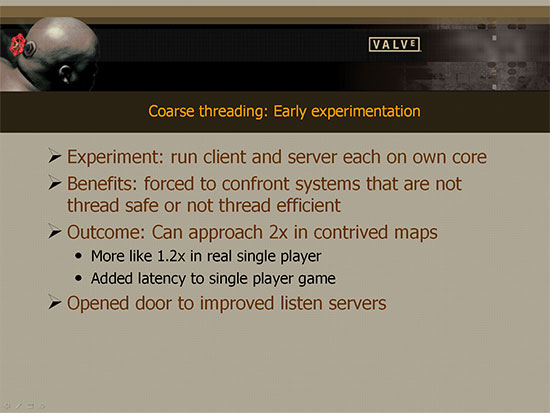
There were benefits to the work that was done, but long-term such an approach is destined to fall short. If you only have a client and a server thread, you are only using two processor cores at most, and even then it is unlikely that you're making full use of both cores. The decision was ultimately reached that the only approach truly worth pursuing as a long-term solution is hybrid threading. It will require the most effort but it will also give the most benefit. As long as you're already rewriting large portions of your engine, the thinking goes, you might as well make sure you do it right so as to avoid doing the same thing again in the near future. The next step is to come up with a threading framework that will allow the developers to accomplish their goals.
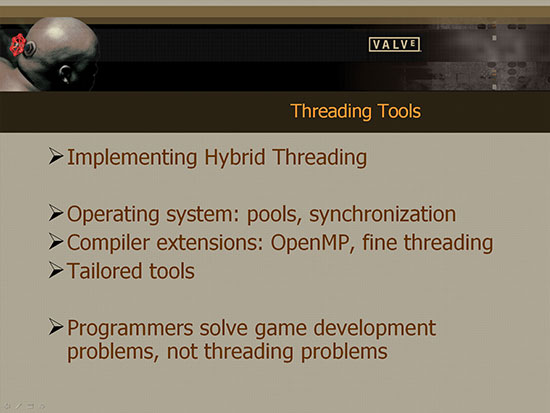
Operating systems and compilers already provide some support for multithreaded programs. In some cases, this support is sufficient, but when it comes to building a real-time gaming engine anything short of a custom threading tool may not provided the desired flexibility. Valve's problems with OS and compiler level threading can be summarized in the following two slides.
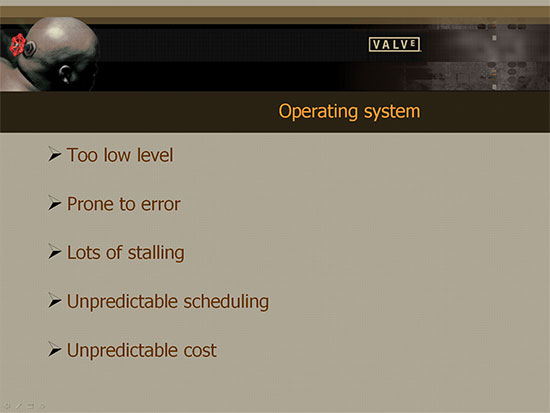
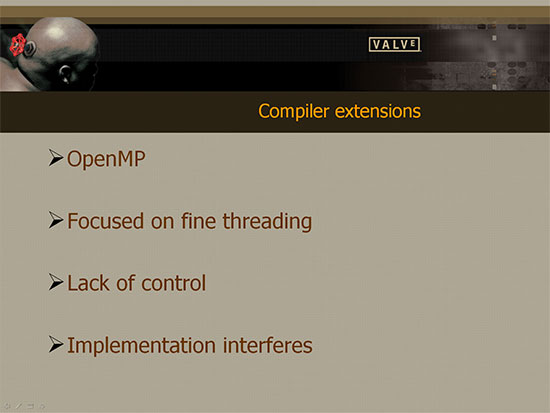
We've already stated several times that making multithreaded programs can be difficult, and the problem is exacerbated when you have many programmers -- some of them junior programmers that have never seen threaded code in their life -- all trying to work together. Valve decided that ultimately what they wanted to create was a threading framework and a set of tools that would allow the programmers and content creators to focus on the important thing, actually creating the games, rather than trying to constantly deal with threading issues. Tom Leonard and a couple other helpers were tasked with creating this toolset, and as you can guess by the existence of this article, their efforts are about to reach fruition.
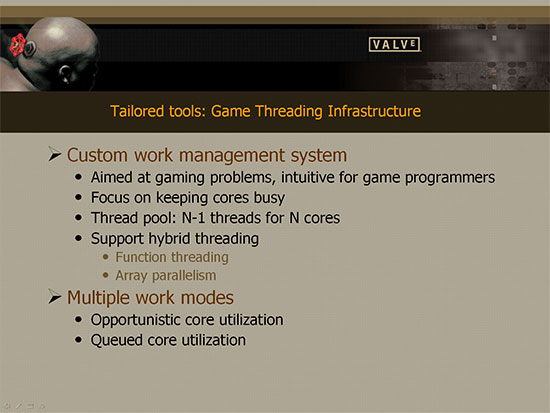
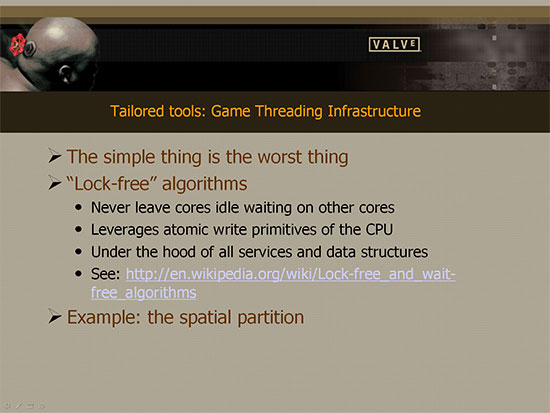
We're not going to try and snowball you with any more information on the low level details at present. Basically, Valve is working hard to provide a toolset that will enable their developers -- as well as mod creators and engine licensees -- to take full advantage of multi-core platforms. They aren't just looking at dual core or even quad core; their goal is to build an engine that is scalable to whatever type of platform users may be running in the future. Of course that doesn't mean they won't be rewriting portions of their engine at some point anyway, but all signs indicate that they should be at the forefront of creating multi-core games and gaming engines.
Valve Software researched and experimented with all three multithreading models, and some of the results were promising. The first thing they did was to look at coarse threading, being that it is usually the easiest approach. Like Quake 4 and Call of Duty 2, Valve also has a client-server architecture in the Source engine, so that's where they started. The results can be summarized with the following slide:

There were benefits to the work that was done, but long-term such an approach is destined to fall short. If you only have a client and a server thread, you are only using two processor cores at most, and even then it is unlikely that you're making full use of both cores. The decision was ultimately reached that the only approach truly worth pursuing as a long-term solution is hybrid threading. It will require the most effort but it will also give the most benefit. As long as you're already rewriting large portions of your engine, the thinking goes, you might as well make sure you do it right so as to avoid doing the same thing again in the near future. The next step is to come up with a threading framework that will allow the developers to accomplish their goals.

Operating systems and compilers already provide some support for multithreaded programs. In some cases, this support is sufficient, but when it comes to building a real-time gaming engine anything short of a custom threading tool may not provided the desired flexibility. Valve's problems with OS and compiler level threading can be summarized in the following two slides.


We've already stated several times that making multithreaded programs can be difficult, and the problem is exacerbated when you have many programmers -- some of them junior programmers that have never seen threaded code in their life -- all trying to work together. Valve decided that ultimately what they wanted to create was a threading framework and a set of tools that would allow the programmers and content creators to focus on the important thing, actually creating the games, rather than trying to constantly deal with threading issues. Tom Leonard and a couple other helpers were tasked with creating this toolset, and as you can guess by the existence of this article, their efforts are about to reach fruition.


We're not going to try and snowball you with any more information on the low level details at present. Basically, Valve is working hard to provide a toolset that will enable their developers -- as well as mod creators and engine licensees -- to take full advantage of multi-core platforms. They aren't just looking at dual core or even quad core; their goal is to build an engine that is scalable to whatever type of platform users may be running in the future. Of course that doesn't mean they won't be rewriting portions of their engine at some point anyway, but all signs indicate that they should be at the forefront of creating multi-core games and gaming engines.










55 Comments
View All Comments
Regs - Tuesday, November 7, 2006 - link
And I hope Valve pulls it off too. Didn't mean nothing with the above post.puffpio - Tuesday, November 7, 2006 - link
Is it just me, or does the pic of Tom Leonard showcase a huge underarm sweat stain? :Ppeldor - Tuesday, November 7, 2006 - link
Tom's pic makes it looks like he's been fighting with multithreading and losing.Badly.
PeteRoy - Thursday, November 9, 2006 - link
I loved your comment.JarredWalton - Tuesday, November 7, 2006 - link
It was taken after about two hours in the conference room. Sorry Tom! :)